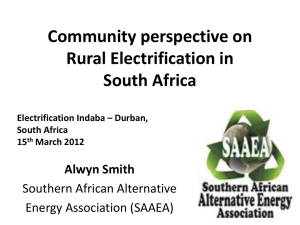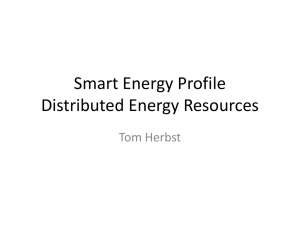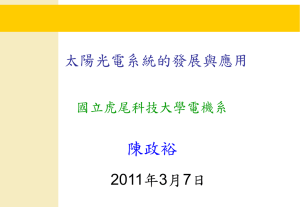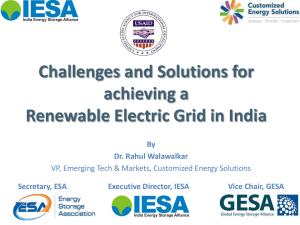Lynn_LVDC_SEGIS_Slides_2011-04-05
advertisement
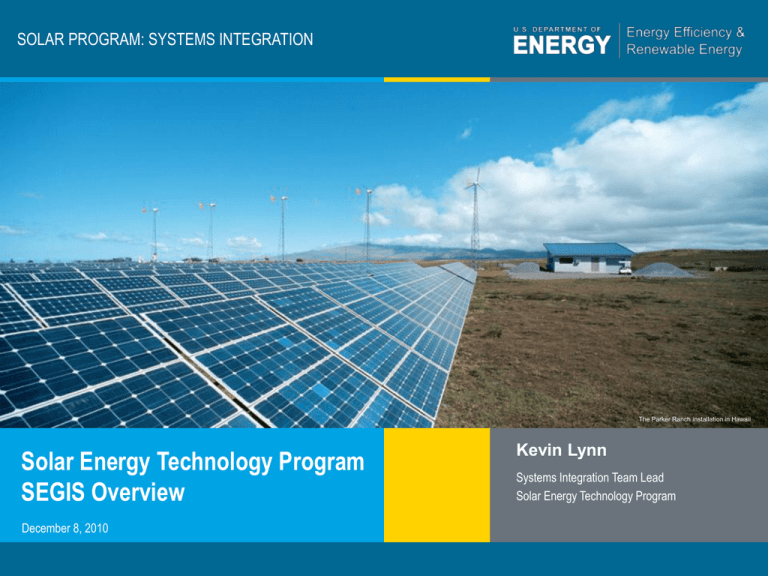
SOLAR PROGRAM: SYSTEMS INTEGRATION The Parker Ranch installation in Hawaii Solar Energy Technology Program SEGIS Overview Kevin Lynn Systems Integration Team Lead Solar Energy Technology Program December 8, 2010 1 | Program Name or Ancillary Text eere.energy.gov What are we doing now: Implementing “Imagine the world”? • Introducing SunShot: we will enable this world • We are working with US industry, national labs and academia to innovate and lay the foundation for a subsidy-free solar electricity infrastructure that is broadly competitive with fossil fuel based electricity 2 | Program Name or Ancillary Text eere.energy.gov What is SunShot? • Price and date targets – 5-6c/kWh installed at the MW scale by end of decade – Unsubsidized grid parity in residential and commercial markets by end of decade • Transformational technologies – PV Modules – BOS – Power Electronics 3 | Program Name or Ancillary Text eere.energy.gov Strong Solar markets enabled by SunShot 20% 18% 16% 14% 12% 10% 8% 6% 4% 2% 0% 2010 Total PV Generation Fraction $1/Watt $1.50/Watt SP targets $2/Watt Reference 2020 2030 2040 2050 Goodrich, Margolis, et al, NREL 4 | Program Name or Ancillary Text 4 eere.energy.gov Vision for Systems Integration • • • Grid Integration – There will be a well established, timely and cost effective process for integrating high penetrations of PV into utility transmission and distribution systems while providing maximum value to the PV system owner and utility. Technology Validation – A solar industry in which uncertainty in performance, lifetime, durability, and availability, has been drastically reduced; thereby reducing risk and the $/W cost associated with that risk. Solar Resource – Characterize and forecast the solar resource to provide better predict the power and energy output of PV systems. Improve the forecast of the solar resource to better integrate solar into electric utility systems. 5 | Program Name or Ancillary Text Grid Integration • • • • Distributed Generation Transmission High Penetration Smart Grid Integration Balance of Systems • System Components R&D • Inverters & Storage • SEGIS SI Technology Validation • • • • Testing & Evaluation Reliability Codes & Standards Modeling & Analysis Solar Resource • • • • Forecasting Mapping Radiometry NOAA & Wind Collaborative eere.energy.gov Mission Statement • The DGI activity’s mission is to reach our vision of integrating high penetrations of solar in a safe, reliable, and cost effective way by: – Developing advanced grid-friendly interconnection solar technologies – Developing validated inverter and system models and simulation tools to support analysis of solar integration on the distribution system – Addressing the variability of the solar system output and developing solutions to minimize the impact on electric power systems – Demonstrating the feasibility(safe, reliable, and cost effective) of high penetration solar scenarios under a wide range of system conditions through lab and field testing – Developing and updating standards and codes that enable high solar penetrations – Collaborating with industry and other stakeholders to inform and get feedback 6 | Program Name or Ancillary Text eere.energy.gov Vision for SEGIS Communication-Connected Distributed Solar and Storage Systems Serving as beneficial distribution system assets allowing greater amounts of solar to be integrated into the utility grid 7 | Program Name or Ancillary Text eere.energy.gov Solar Energy Grid Integrations Systems (SEGIS) • Add SEGIS Slides Here 8 | Program Name or Ancillary Text eere.energy.gov SEGIS Stage 3– Status SEGIS Stage 3 Downsized from five to four Contractors Lead Company Short Project Title Apollo Solar Advanced Grid-tied Inverter, Charge Cont, Energy Monitor, Internet Gateway EMTEC SEGIS - Emerson PV Inverter Development Enphase Nano-inverters with VAr Control and EMS GE Grid Integration of High-penetration Solar Energy Nextek Power Sys PV Interface Providing Concurrent AC & DC Power Network Support Petra Solar Economically Viable, Highly Integrated, Highly Modular SEGIS Architecture Premium Power Intelligent PV Inverter Princeton Power Demand Response Inverter PV Powered MPPT and EMS Advancements Smart Spark Alternating Current PV Module with System Interface U Central FL –FSEC Grid-Smart Inverters VPT Inc 9 | Program Name or Ancillary Text Inverter Cont Card (ICC), Bidirectional Power Conversion(BPC), Power Hub Control (PHC), Integrated Power Hub (IPH) eere.energy.gov Maximum Power Point Tracking, Advanced EMS and Utility Integration (PVPowered) Technologies Addressed Optimized Performance Algorithms, Advanced Data Collection, Communications and Energy Management Systems (EMS). Description PV Powered and its team will develop a suite of maximum power point tracking (MPPT) algorithms to optimize energy production from the full range of available and emerging PV module technologies. The work will also develop integration of communications with facility energy management systems and utility grid management networks. Participants Lead PVPowered Dr. Steve Hummel Resources ($) DOE Max (3 stages) DOE Stage1 (max) Cost Share per stage $6,250K $250K 20% - 20% - 50% 10 | Program Name or Ancillary Text Portland General Electric South Dakota State University Northern Plains Power Technologies eere.energy.gov PV Powered SEGIS Program Objectives Challenges High Penetration of PV results in: – Voltage instability – Power quality – Safety – unintentional island Reducing Levelized Cost of Energy (LCOE): – Energy Harvest – Total System Cost 11 | Program Name or Ancillary Text Program Objectives 1. Develop and commercialize – Alternate island detection technique using synchrophasors – Next generation utility command and control functions 2. Deploy next generation inverter system to sites with utility integration challenges 1. Develop and commercialize advanced MPPT algorithm that works with all PV technologies 2. Dynamic MPPT test plan 3. Develop communications protocols and validate PV system compatibility with facility energy management systems 4. Develop and commercialize advanced inverter communications platform for emerging smart grid eere.energy.gov Stage 2 Projects and Core Team Task Description Lead “Task 1” Advanced MPPT Michael Mills-Price “Task 2” EMS Integration Eric Valleton “Task 3” String Monitoring and Control Mesa Scharf “Task 4” Mitigation of Weather Transients Michael Ropp “Task 5” Utility Communications and Control Michael Mills-Price “Task 6” Platform Integration Secondary controller and UI SEGIS DB and API Mesa Scharf 12 | Program Name or Ancillary Text eere.energy.gov Advanced BOS Balance of system optimization – – – – – Next generation smart combiner Power over DC bus Communications over DC bus Ground fault detection per string Interrupt per combiner System integration – – Data flows through comm. hub in inverter to central database Data made available to relevant stakeholders 13 | Program Name or Ancillary Text eere.energy.gov Petra Solar: Economically Viable, Highly Integrated, Highly Modular SEGIS Architecture Technologies Addressed Smart Grid Interconnection, System Cost, Modularity, System Reliability, Safety, and Advanced Scalable Inverters. AC PV modules aimed at utility ownership and control. Description Smart Grid Interconnection, System Cost, Modularity, System Reliability, Safety, and Advanced Scalable Inverters. low cost, easy-to-install, modular/scalable inverter architectures that are scalable from 5kW to 20kW. Advances in multi-layer control, communications, monitoring and controlling a cluster of AC module inverters, and a strategic EMS switch junction box Funding($) DOE/Cost Share Stage 1 Stage 2 Stage 3 $100K/$374K $2.993M/$3.0M $3.0M/$5.278M Recommendation: Yes Advanced their 120V AC Module system to 240V SEGIS system, all functionalities operated as proposed, communication advances good, transition from legacy to SEGIS mode meets UL today, NO witness test failures, potential to greatly improve cost and reliability with 3 integrated circuits under development, no thermal issues, stated utility marketing plan, utility partners ID’ed for demo, US manufacturing in place. Participants Petra Solar, Florida Power Electronics Center, Florida Solar Energy Center, Lakeland Electric, Echelon, PSE&G, First Energy, Pepco Holdings PROPRIETARY INFORMATION - PLEASE DO NOT CIRCULATE 14 | Program Name or Ancillary Text eere.energy.gov Development, Validation and Commercialization of Grid-Smart Inverters for Wider PV Technology Utilization (Florida Solar Energy Center at UCF) Technologies Addressed Utility Control of Enhanced Inverter Features, Disturbance-tolerant Anti-Islanding, Shared Inverter, Energy Storage, Building Interaction. Description The FSEC and UCF team will develop new concepts and enhance “Smart Grid” development. A “shared” inverter serving multiple residential or commercial PV arrays located at a distribution transformer will be developed. Work includes battery storage, utility control, communication, monitoring, or building energy management systems (BEMS). An “anti-islanding” strategy that allows PV on line during grid disturbances will improve grid stability. New inverter architectures will bring more stability to the grid. Resources ($) DOE Max (3 stages) DOE Stage1 (max) Cost Share per stage $6,250K $250K 20% - 20% - 50% 15 | Program Name or Ancillary Text t Participants 0 Lead SatCon University of SENTECH Inc. Central Florida EnFlex Robert Reedy (FSEC/UCF) SunEdison Northern Plains Power Technologies Lakeland Electric Utilities eere.energy.gov Economically Viable, Highly Integrated, Highly Modular SEGIS Architecture (Petra Solar) Technologies Addressed Smart Grid Interconnection, System Cost, Modularity, System Reliability, Safety, and Advanced Scalable Inverters. Description Petra Solar and its team will advance grid interconnection, cost reductions, system reliability, and safety through low cost, easy-to-install, modular and scalable inverter power architectures that are scalable from 5kW to 20kW. Advances include multilayer control, communication architecture, monitoring and controlling a cluster of AC module inverters, and a strategic EMS switch junction box. Resources ($) Participants Lead Petra Solar DOE Total DOE Stage 1 Cost Share (total) $6,250K $250K 20% - 20% - 50% 16 | Program Name or Ancillary Text Adje Mensah Florida Power Electronics Center Florida Solar Energy Center Lakeland Electric Echelon BP Solar Evergreen Solar eere.energy.gov SEGIS System Architecture Utility grid AC PV systems Wide Area Networks Web interface AC –coupled storage Control and Comms. Module (ConCom) SEGIS Development Highlights 17 | Program Name or Ancillary Text 17 eere.energy.gov Florida Solar Energy Center at UCF / Satcon: Development, Validation and Commercialization of Grid-Smart Inverters for Wider PV Technology Utilization Technologies Addressed Utility Control of Enhanced Inverter Features, Disturbance-tolerant Anti-Islanding, Shared Inverter, Energy Storage, Building Interaction Description Develop new concepts and enhance “Smart Grid” development. Develop “Shared” inverter and controls that serve multiple PV arrays. Include battery storage, utility control, communication, monitoring, or building energy management systems (BEMS). Develop an “anti-islanding” strategy that keeps PV on line during grid disturbances to improve grid stability. Funding($) DOE/Cost Share Stage 1 Stage 2 Stage 3 $250/$67K $1.350M/$732K $725K/$725K Recommendation: W/ Funding The subcontractor (Satcon) advances PV emerging into smart grids with the utility controlling islanding and under voltage ride thru functionality. The dc-dc conversion and a dc bus adds flexibility for energy storage and micro-grid. The string combiner can improve performance, safety and reliability while enabling mixed PV technologies, optimal energy harvest, reduced BOS costs, and optimal inverter performance. Utility permissive control allows LVRT, VAR sourcing, constant PF control. Demo plans in place with Lakeland, Participants UCF/FSEC, SatCon, SENTECH Inc., SunEdison, Northern Plains Power Technologies, Lakeland Electric, Cooper Power Systems EAS PROPRIETARY INFORMATION - PLEASE DO NOT CIRCULATE 18 | Program Name or Ancillary Text eere.energy.gov SEGIS-FSEC Team: GSIA, System Functionality Grid-Smart Inverter Architecture Utility control capabilities Advanced power management functions Ride-through capability Grid-Smart Shared Inverter String level conversion and MPPT Mitigation of shading, soiling, mismatch losses Enhanced safety – better detection and reporting of fault currents Site Controller Aggregate control of inverters – optimized management of resources PLC Anti-Islanding More reliable anti-islanding Enables ride-through 19 | Program Name or Ancillary Text eere.energy.gov SEGIS-FSEC Team: System Advantages • Utility Control Options – Local autonomy and fallback modes when not available or wanted • Secure Ride-Through when generation is needed most – Anti-Island method fast & secure under all contingencies. – Handles most common problem: 1 phase down-wire with 3 phase inverters downstream (frequency does not change, power angle does not drift) • Stiffens entire grid load-up, rather than plant-down – VAR supply/sink today – Transient real power (inertia) tomorrow (w/ fast storage on DC bus) • Shared Inverter with string-level Converter – Economic advantages – Fire and shock safety advantages – Improved integration with regulated DC bus (e.g. integral storage, DC networks) 20 | Program Name or Ancillary Text eere.energy.gov SEGIS-FSEC Team: Shared Inverter Concept 21 | Program Name or Ancillary Text eere.energy.gov SEGIS-FSEC Team: Shared Inverter Concept • System architecture with regulated DC bus 22 | Program Name or Ancillary Text eere.energy.gov
